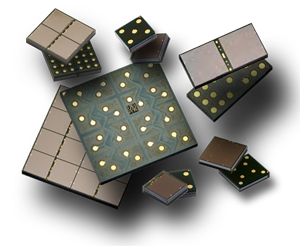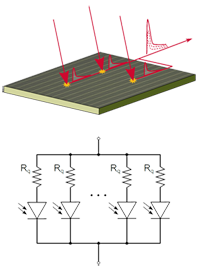 The Silicon Photomultiplier (SiPM) addresses the challenge of detecting, timing and quantifying low-light signals down to the single-photon level.
The Silicon Photomultiplier (SiPM) addresses the challenge of detecting, timing and quantifying low-light signals down to the single-photon level.
Traditionally the province of the vacuum Photomultiplier Tube (PMT), Avalanche Photodiode (APD), or PIN photodiode with high-gain amplifier, the SiPM now offers a highly attractive alternative that closely mimics the low-light detection capabilities of the PMT while offering all the benefits of a solid-state device - low voltage operation, insensitivity to magnetic fields, mechanical robustness and excellent uniformity of response.
Due to these traits, the SiPM has rapidly gained acceptance in the fields of medical imaging, hazard and threat detection, biophotonics, high energy physics, LiDAR and other low light, high speed applications.
 The building block of all SiPMs is a square micro-APD which is operated at a stable point above the Breakdown Voltage (VBR) in "Geiger-mode". The bias above breakdown is known as the "Overbias" (VOB) - hence the operating bias is VBR + VOB. Breakdown Voltage varies with operating temperature and this is discussed later.
The building block of all SiPMs is a square micro-APD which is operated at a stable point above the Breakdown Voltage (VBR) in "Geiger-mode". The bias above breakdown is known as the "Overbias" (VOB) - hence the operating bias is VBR + VOB. Breakdown Voltage varies with operating temperature and this is discussed later.
Each micro-APD is in series with a quenching resistor and the combination is referred to as a Single Photon Avalanche Diode "SPAD" or "microcell". The SiPM comprises many thousands of SPADs which are electrically decoupled by the quenching resistors.
Incident photons are detected by individual SPADs which avalanche and release a fixed and repeatable charge with a Gain greater than one million. This signal is easily measured above the noise floor of following preamplification circuits - a key advantage over APD-based technologies. As this charge flows through the quenching resistor the bias voltage droops, stemming the avalanche and resetting the SPAD bias to a steady Geiger-mode state ready to detect the next incident photon.
Individual SPADs are therefore "single photon sensitive" and since the output of the SiPM is the sum of the charge contributions of each photon detected it is possible to determine the number of photons by analysing the height of each pulse. The following plot shows typical SiPM response from 1 to 6 simultaneous photons with a transimpedance gain of 2V/A:-

In the first order approximation the signal can be described using a double-exponential function with a rise-time constant of a few hundred picoseconds and a recharge time constant of 55ns (NUV-MT, 12V overbias). The plot clearly demonstrates the uniform charge per photon and the potential to determine the number of photons per event.
The pulse shape above hints at the presence of fast frequency components which can be extracted using a high-pass filter. This approach is discussed in more detail in the Timing Characteristics support page.
As with any detector, SiPMs will exhibit Dark Counts caused by thermal electrons triggering an avalanche. Since these Dark Counts are the discharge of a single SPAD they are indistinguishable from the signal of a detected photon and so a low Dark Count Rate (DCR) is desirable. As they are caused by thermal electrons Dark Counts increase with increasing temperature, doubling every ~9-10°C. Overbias also influences the DCR with a positive coefficient.
Noise in SiPMs is also influenced by Crosstalk and Afterpulsing. In order to reduce the optical crosstalk probability between individual SPADs NUV-MT SiPMs incorporate a very narrow "Metal-filled Trench", hence the NUV-MT name. Other performance-improving techniques include improved impurity gettering and parasitic RC-value reduction. DCR, Crosstalk and Afterpulsing are discussed in more detail in the Noise support page.
Broadcom's latest NUV-MT series SiPMs feature a SPAD pitch of 40µm. Larger SPADs hold a higher charge and so have higher Gain - in the case of the 40µm pitch NUV-MT technology the Gain is 7.3x10^6 (12V Overbias). The charge on the SPAD, and hence the Gain, increases with increasing Overbias. Additional information can be found in the Gain support page.
Since the SiPM comprises the micro-APD together with the quenching resistor, the interconnecting circuitry and the trenches between the microcells it can be seen that the Quantum Efficiency of the micro-APD itself is only one aspect of the "Photon Detection Efficiency" (PDE) of the SiPM. The large 40µm SPAD pitch and efficient design of NUV-MT SiPMs also produces a high geometric fill factor of micro-APD active area. In combination with high Quantum Efficiency this produces SiPMs with industry leading PDE of 63% (12V overbias). PDE increases with increasing Overbias and additional information can be found in the Photon Detection Efficiency support page.
Clearly the SPAD pitch limits the total number of SPADs for a given SiPM active area - the AFBR-S4N44P014M "4mm" SiPM has an active area of 3.74x3.84mm² with 8622 SPADs; the 6.14x6.14mm² AFBR-S4N66P014M has 22428.
The number of SPADs is significant in terms of Saturation and Linearity performance of SiPMs. In the case of fast pulse events it is a physical limiting factor to the number of instantaneous photons detected; with longer signals such as scintillator readout it combines with the recharge time, SPAD quenching resistor and capacitance and the series load resistance to define saturation. For this reason manufacturers typically quote a load resistance for all Tau figures and it is important to note this value when comparing Tau as low series resistance of a few Ohm will result in significantly faster performance. Additional information can be found in the Linearity and Saturation support page.
As mentioned previously the breakdown voltage of SiPMs varies as a function of temperature so it can be appreciated that if the operating bias is fixed then the Overbias will change with temperature. Since the characteristics of SiPMs vary with Overbias the SiPM's performance changes with temperature.
In the vast majority of uses SiPMs are used with a fixed Bias Voltage as small changes in Overbias are not critical. In cases where temperature effects need to be accommodated then active control of the Bias/Overbias can be used to stabilise Gain and PDE. Temperature stabilisation using thermoelectric coolers or other techniques is rarely cost effective.
Where Gain and PDE stabilisation is required users take advantage of the NUV-MT's low and predictable coefficient of +30mV/°C by monitoring the temperature and adjusting the bias voltage so that a constant Overbias is maintained. Manufacturers of products such as handheld spectroscopic radiation detectors will use this approach to stabilise Gain and PDE so that a particular energy peak will always occur in the same Multi-channel Analyser (MCA) channel.
It should be noted that the overbias stabilisation approach WILL NOT affect other temperature-driven affects such as the increase in Dark Count Rate (DCR) and associated Dark Current - it is therefore important to consider the operating temperature range of a system employing SiPMs to ensure that the minimum signal remains detectable at the maximum operating temperature. In the case of the handheld spectroscopic radiation detector this would mean ensuring that the Noise level remains below the minimum detectable energy channel of the MCA.
This might be achieved by reducing the Overbias - for example the DCR of the NUV-MT technology is 125kcps/mm² at 12V Overbias and halves to ~62.5kcps at 7V. Since Gain and PDE is also reduced this approach does compromise the performance at lower temperature levels since SiPMs are rarely used with dynamic Overbias control to actively change characteristics - the typical use is to stabilise Gain and PDE. Additional information can be found in the Breakdown Voltage support page.
Broadcom have produced Application Notes providing background information for both new users and those more familiar with SiPMs:-
For more detail please visit the Support pages using the links in this article and on the right hand side of this page.


